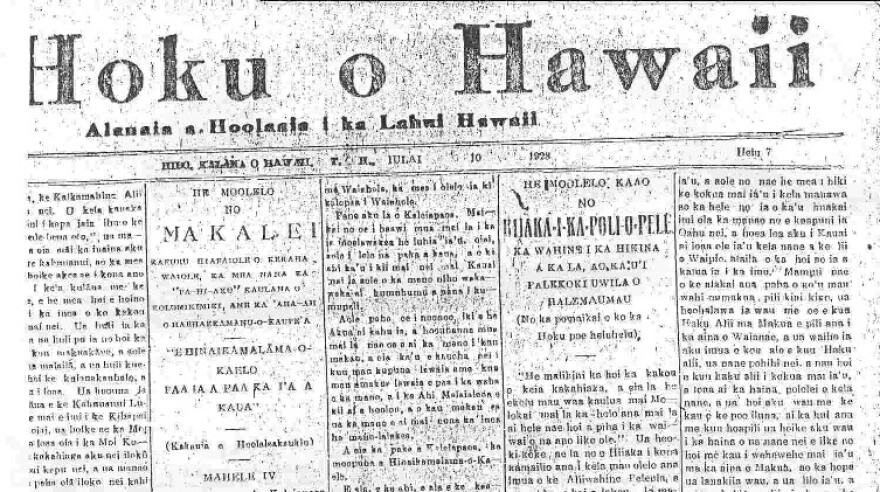Today, a majority of Hawaiian fishponds have been lost to coastal development and urbanization. But a growing, community-based movement is working to restore these fishponds as a foundation for sustainable fish production. Researchers at the University of Hawai’i at M?noa are now looking to Hawaiian language newspapers for help. HPR’s Ku?uwehi Hiraishi reports.
Brackish water flows through the gates of the restored He?eia Fishpond into K?ne?ohe Bay. The 800-year-old fishpond is one of only 14 in production statewide. At the turn of the 19th century, more than 450 fishponds across the island chain produced more than 2 million pounds of fish per year.
 The Alekoko Menehune Fishpond on Kauai, ca. 1912, showing water flowing in from Huleia Stream (top left) and, in the foreground, an elaborate ‘auwai with a guard house.
The Alekoko Menehune Fishpond on Kauai, ca. 1912, showing water flowing in from Huleia Stream (top left) and, in the foreground, an elaborate ‘auwai with a guard house.
Credit Bishop Museum Archives
“It’s important for us to eat from this place yeah?” says Hi?ilei Kawelo, Executive Director of Paepae O He?eia.
For the last 16 years, she and her non-profit have rallied the surrounding community to restore the 88-acre fishpond in windward O?ahu by removing mangrove, rebuilding the wall, and populating the pond with fish.

“We see schools and schools of mullet. We see schooling moi. We see big awa. We see big ‘??io. And they all come to the gates. And that’s what we want to see,” says Kawelo. “That’s how we know that the restoration work here is proven and has been successful.”

Kawelo says they’re not at a point where they can harvest and distribute fish on a large scale, but that is the goal - a goal that almost didn’t happen. In 2009, the fishpond was hit by two major fish kills. The first came on a typical summer day…
“Beautiful. Sun’s blazing. The morning was a really low tide….and there was no wind,” says Kawelo, “and that’s the perfect recipe for an oxygen-depleted system.”
This happened twice that year, killing an estimated 13,000 fish. A recent study out of the University of Hawai’i at M?noa says climate change is the culprit.

“It was an el Niño that happened,” says Dr. Rosie Alegado, a researcher at UH M?noa’s School of Ocean and Earth Science and Technology,” So during el Niño in Hawai’i, we know that the trade winds don’t come as much. We get what we know as Kona weather – it’s hot and sticky. And in addition to that, sea surface temperatures are higher, so the waters are warmer. And those two conditions can be pretty stressful for marine life.”
Alegado is one of the authors of the study.
“What it made me wonder was did this kind of event happen you know ma ka w? kahiko, to our k?puna? And what did they do to combat this?” says Alegado.

To do this, Alegado is looking to the repository of Hawaiian language newspapers published as early as the 1830s. So far, she’s only found one case of a fish kill in a fishpond, but no relation to a changing climate.
“What it tells us is maybe these events weren’t that strong in the past as it is now,” says Alegado, “And what it really more strongly points to is I think our k?puna were able to predict perhaps more in advance these weather patterns and weather systems and they were able to make these fishponds more resilient”
Fishpond restoration at He?eia is about two-thirds of the way to complete. As climate change is predicted to alter the intensity and frequency of el Niño events, Kawelo too looks to the past.
“Really our response to a changing climate is to do what our k?puna did. Be outside, pay attention and adjust,” says Kawelo, “You know, we can evolve. Our people can evolve. We have to evolve.”




